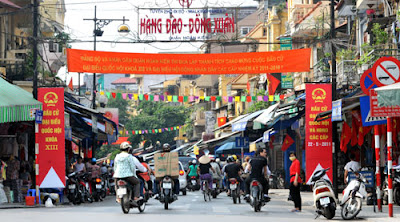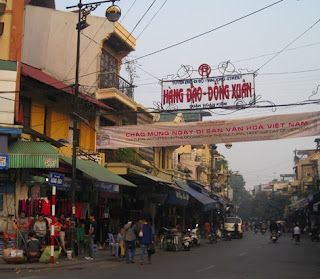Hang Dao Street - The silk dyer street
Background information
 Hang Dao is one of the oldest streets in Vietnam, its location is in the Old Quarter, The Restored Lake District, Hanoi. “Hang” means street and “Dao” is the name of one silk dyer having the pink of apricot blossoms, which are symbolic of the Vietnamese Lunar New Year. In the first years of the 15th century, this street was very famous with this silk so that people named it is “Hang Dao”, based on its characteristic.
Hang Dao is one of the oldest streets in Vietnam, its location is in the Old Quarter, The Restored Lake District, Hanoi. “Hang” means street and “Dao” is the name of one silk dyer having the pink of apricot blossoms, which are symbolic of the Vietnamese Lunar New Year. In the first years of the 15th century, this street was very famous with this silk so that people named it is “Hang Dao”, based on its characteristic.
Nowadays, Hang Dao is still one of the main streets in Hanoi. Its length is 260 meters and runs from north to south, cutting the Old Quarter in half. The southern border of the street is Dong Kinh Nghia Thuc Square, closing to Hoan Kiem Lake. The northern border is the Transversal Street (Hang Ngang). The street’s west has even number and the east has odd number.
History
From the 15th and 16th century, people from different places, especially from Hai Duong province, had to set up Dai Loi Ward. It is professional in dyeing silk. Since then, Hang Dao has become a center for dyeing silk and become the most crowded and noisiest street in Hanoi at that time.
 On the first and sixth days of lunar month, there were fairs for the sale of silk items. It attracted many people and villages of silk such as La a, La Khe, the Grapefruit village - the coastal village of the West Lake, Van Phuc Village and so on.
On the first and sixth days of lunar month, there were fairs for the sale of silk items. It attracted many people and villages of silk such as La a, La Khe, the Grapefruit village - the coastal village of the West Lake, Van Phuc Village and so on.
In 1986, when the innovation policy of the State is opening the market economy and economic integration, Hang Dao Street was awaken with the emergence of a range of groceries, watches, clothing and many tall buildings. They completely changed the face of Hang Dao street. Hang Dao became the place selling city maps for foreign tourists.
Hang Dao Street at the present
Nowadays, Hang Dao Street is one of the most expensive areas in Vietnam. Going along this street, tourists will catch so many clothes shops that almost cover the street. Instead of dyeing silk, nowadays, Hang Dao people sell every kinds of clothes all the year, makes the street colorful, crowded and crazy just like many other streets. But the traditional values are still reserved by people and authorities. Looking up we see that the ancient windows and roofs are patiently defending to the time, weather and the developing modern life. Since 2006, Hang Dao Street has been as the night walking market opened every Friday, Saturday and Sunday night.
As we have said before, Hang Dao Street is almost covered by clothes shops, so there are not many hotels or restaurants along the street. More detail, the only hotel we catch on Hang Dao Street is Serenade Hotel at 58, a 3-star hotel with 4 floors.
As you know, Hang Dao is a major shopping street in the trading centre of Ha Noi's Old Quarter. And there are some tourist attractions in the street like 38 Hang Dao street and 51 Hang Dao street.
38 Hang Dao street
The house at 38 Hang Dao street was formerly Dong Lac communal house (brassiere selling market). The communal house was built in the Le dynastic time (the seventeenth century) in large scale. It was badly damaged by the war and in 1856 (Binh Thin lular year of Tu Duc Period), it was restored.
In 1941, the owners rebuilt the house and added a storey. They used the ground floor as living quarters and installed a family altar on the first floor. The house has a stone stele over 150 years old of a type rarely found in Hanoi’s surviving communal house. Other original features include many fine decorations. Of particular note is the carved head of dragon. The State-owned Hanoi Trading Service used the house as a department store from 1956 to 1999.
Then the Hanoi People’s Committee and the city of Toulouse, France selected the house for part of the plan “Preservation and Renovation of the Old Quarter”. Craftsmen using traditional construction techniques renovated the house, which was officially inaugurated in April 2000.
51 Hang Dao street
The house at 51 Hang Dao street, for instance, was built in 1930 for one family, its ancestral altar and the family silk business. Although built later than the “tube house”, that architectural tradition influenced its structure. The ground floor contains a shop, common room, sleeping room, inner yard, kitchen, backyard and toilet. The upstair has a small room, a courtyard linking the roofs of the house, a room for ancestral worship and a large yard for silk drying. The house is three meters wide and fifty meters long. Sunlight enters through open yards and courts, creating a pleasant atmosphere.
Then in 1954, after defeat of the French, a second family of eight moved into the house, living in the outer room of the upper floor while the former owners occupied the rest of the house. Since the house is narrow, the second family had to pass through the first family’s space to reach its own quarters. Both families shared the inner yard, kitchen and the back garden.
Now, the house at 51 Hang Dao street is a portrait-drawing business operated by three artists. The shop itself is in the room facing the street, while the room behind serves as the drawing workshop. Three generations live in the house. The grandfather helps two of his children run the shop in the evening. Others in the household earn their living outside the Old Quarter.
Walking street.
 Hang Dao street is very suitable for walking tourists because as I said before, Hang Dao street is a most popular shopping street in Ha Noi's Old Quarter. There are so many stores and places for tourists come to visit and buy souvenirs, silk, clothes... It’s a fine example of a restored traditional Old Quarter house like the house at 38 Hang Dao. You can also visit the house at 51 Hang Dao to have a portrait drawing and learn more about the old architecture of Hanoi, the Hanoian lifestyle in the Old Quarter...
Hang Dao street is very suitable for walking tourists because as I said before, Hang Dao street is a most popular shopping street in Ha Noi's Old Quarter. There are so many stores and places for tourists come to visit and buy souvenirs, silk, clothes... It’s a fine example of a restored traditional Old Quarter house like the house at 38 Hang Dao. You can also visit the house at 51 Hang Dao to have a portrait drawing and learn more about the old architecture of Hanoi, the Hanoian lifestyle in the Old Quarter...
I hope this is a memorable place when you travel to Vietnam.












0 comments:
Post a Comment